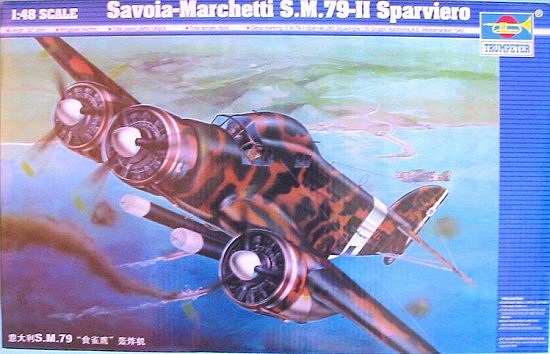
|
KIT: |
Trumpeter 1/48 SM 79-II |
|
KIT # |
2817 |
|
PRICE: |
¥4800 (about $41.00) |
|
DECALS: |
One Aircraft |
|
REVIEWER: |
|
|
NOTES: |

|
HISTORY |
As William Green said in "Famous Bombers of the Second World War," Volume 2, of the S.M.79 Sparviero, "everything that the Spitfire was to the British and the Zero to the Japanese, the Sparviero was to Italy." The greatest Italian aces of the war were the crews of the Squadriglie Aerosiluranti, who made life hell for the Royal Navy in the "Sea of Storms" for two crucial years of the war.
The Savoia-Marchetti S.79 began life in 1933 on the design board of Allessandro Marchetti, chief designer of the Societa Idrovolanti Alta Italia (SIAI) as a three-engined, eight-passenger airliner, to be entered in the coming NacRobertson London-Melbourne Air Race. The airplane had the first retractable landing gear applied to any Italian design. Unfortunately the design could not be readied in time for the race, as the first prototype, registered I-MAGO did not take flight until October 8, 1934. General Guiseppe Valle, Chief of Staff of the Regia Aeronautica used the airplane for a tour of Italian East Africa in August 1935, and became an enthusiastic supporter of the design; his support was crucial since the air staff believed the trimotor concept was obsolete for a bomber.
By 1936, the bomber version was in production, and the S.79 entered service with the Regia Aeronautica in December 1936; it was known as the Sparviero, or "Sparrow Hawk." The bomber was faster than contemporary fighters. It was still unwanted by the air staff because of the engines and defensive armament, but of all the competing designs it was the only one to find any success - the others ranged from deadly to the pilots to merely poor in performance. The S.79 first saw combat in the Spanish Civil War, flown by the Aviacion del Tercio. The bomber had yet to meet determined modern fighter opposition in its career, since the only Republican fighter that had a chance of catching it was the I-16. When Italy entered the Second World War in June 1940, the S.79 was soon found to be very vulnerable to RAF Hurricanes in North Africa.
The S.79 found its true calling when the airplane was modified to carry a torpedo, and the first aerial torpedo bomber squadron was formed in August 1940. After the surrender of the Fascist regime in 1943, the S.M.79 fought on both sides for the remainder of the war.
|
THE KIT |
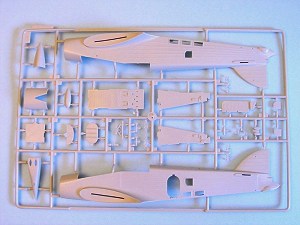 |
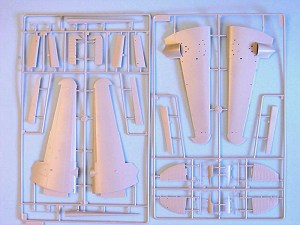 |
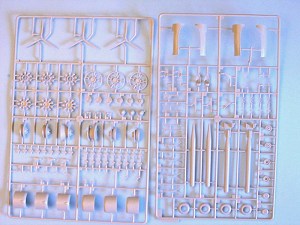 |
When Trumpeter was first revealed to the world, I was not much impressed with their 1/32 MiG-15 and MiG-17 kits. When I later purchased their 1/48 MiG-15, I was impressed that this one was "right" as regarded outline accuracy; unfortunately, kit engineering and parts fit left so much to be desired that this became only the third kit ever in my modeling career to not only go against the wall but to be stomped into its component atoms after coming to the realization there was no way one could follow the instructions and end up with a correctly-assembled model.
Then there was the 1/24 Mustang disaster, followed shortly by the 1/32 Wildcat misfire. When the 1/24 Spitfire Vb turned out to be good, I thought perhaps they had finally gotten their act together. Then I recently saw what a crock the soon-to-be released 1/24 Zero 21 is, and decided the Spitfire must have been a fluke. Thus, when the opportunity came to get a review copy of the 1/48 S.M.79-II "Sparviero," I was a bit hesitant when it came time to open the box.
Surprise! It's not terrible!
In actual fact, outside of a couple of minor glitches, the model looks pretty good on the sprues. The glitches are that the cockpit interior is nowhere near as detailed as that of the Classic Airframes limited-run kit; given that the kit is also not designed to have the gunner's position at the rear of the "humpback" opened up (as you can do with the CA kit), the lack of cockpit detail is not so obvious. In fact, given the "clarity" of the cockpit canopy clear part, you won't be able to see a thing inside unless you Future the part before assembly.
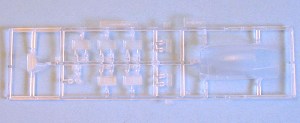 As opposed to
the CA kit, this kit from Trumpeter has a rear entry hatch that can be
opened, and there is some aiframe detail molded to the interior of the
fuselage. One will still have to blank off the area forward of the hatch
for the bomb bay, but that is not difficult.
As opposed to
the CA kit, this kit from Trumpeter has a rear entry hatch that can be
opened, and there is some aiframe detail molded to the interior of the
fuselage. One will still have to blank off the area forward of the hatch
for the bomb bay, but that is not difficult.
The one real negative I see with the model is that the fabric-covered frame detail of the rear half of the fuselage and the tail surfaces is hugely overdone and will need to be sanded off. The fabric on the real airplane was very tight, and would best be portrayed by some "pre-shading" of the airframe longerons and ribs before painting the camouflage.
The detail parts - engines, props, landing gear, etc., look good. The two torpedoes provided are accurate in length and look - do remember, however, that the Aerosiluranti only carried one torpedo in combat.
So, given the disasters of the Mustang, Wildcat and Zero, does it look like an S.M.79??
I cut the fuselage and wings off the sprue after photographing them, and compared them with the similar parts of the second-release Classic Airframes kit, a model that when it is constructed looks surprisingly like what it is supposed to be. The Trumpeter parts could be interchanged with the CA parts, though the difference between a mainstream high-pressure injection molded kit and a limited-run low-pressure injection-molded kit are obvious and one would not want to do a "mix and match" for real. My point here is that the parts are similar in outline and general shapes. Additionally, the design of the wings for the Trumpeter kit makes for easier assembly than does that of the CA kit.
|
CONCLUSIONS |
This kit will make up into the "classic" S.M.79-II, which can be done as either a level bomber or as a torpedo bomber. The kit only comes with the one sheet of decals, so a modeler will need to have saved the extra decals from their first C-A kit last year, or purchase the SkyModels sheet (beware that the placement instructions in that sheet are not correct for any of the airplanes for which markings are provided - check photos for the one you choose to do) if you want a different airplane than that for which this kit provides.
Modelers who dislike the "modeling skill required" part of working with limited-run kits will find this easier to assemble, and about as accurate-looking once completed. The main U.S. mail order house has this listed at US$49.95, which is not that much less than the C-A kit. HobbyLink Japan's price of US$41.00 is a good price even factoring in shipping, and HLJ has it now, for those who need their immediate gratification immediately.
Bottom line: if you are only going to do one S.M.79 for your collection, and already have the CA kit, you don't need to run out and get this one. If a fear of limited-run kits has prevented you getting that kit, then this one would be the answer for you.
What I want to know is, where did all these Sparvieri here at Le Chateau du Chat come from??? A year ago you couldn't get a 1/48 injection-molded S.M.79 to save your soul, and now I have a herd! I guess it could be worse. If Trumpeter can just stick to this quality and accuracy with the 1/48 Wellington next year, I will be a happy camper.
Review kit courtesy of HobbyLink Japan
If you would like your product reviewed fairly and quickly by a site that has over 200,000 visitors a month, please contact me or see other details in the Note to Contributors.